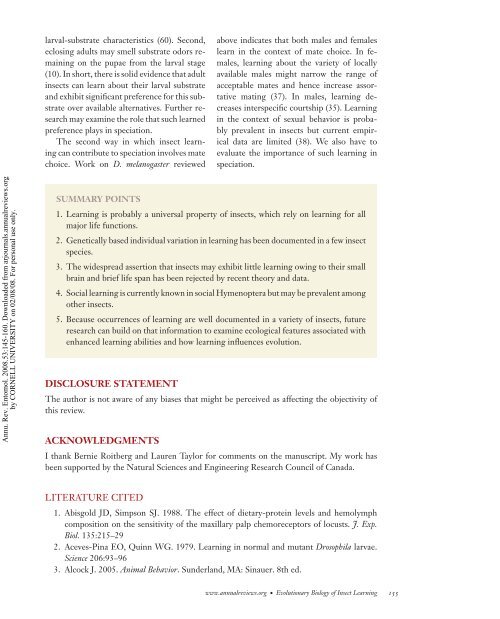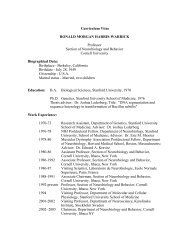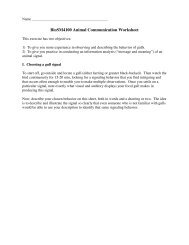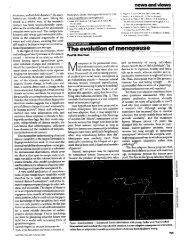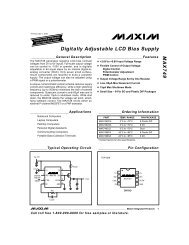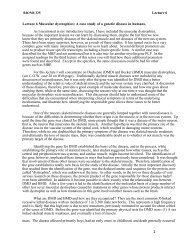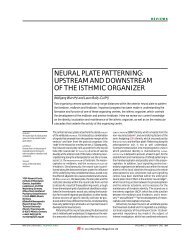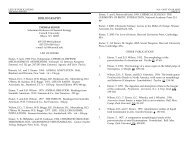Annu. Rev. Entomol. 2008.53:145-160. Downloaded from arjournals.annualreviews.orgby CORNELL UNIVERSITY on 02/08/08. For personal use only.Speciation: theformation <strong>of</strong> a newbiological speciesobserver ant, a model ant moves from the nestto the food source 25% slower than when travelingalone. The model ant adjusts her speed,slowing down when the observer ant is delayedand accelerating when the observer isfollowing closely. Tandem running in the antT. albipennis was formally described as a case<strong>of</strong> teaching (49), which is a highly restrictivecategory <strong>of</strong> social learning. Currently, onlyone other case <strong>of</strong> teaching in nonhuman animalshas been confirmed (107). In addition torecruiting nestmates to distant food sources,social bees can also copy the flower choice<strong>of</strong> experienced foragers. Experiments in twolaboratories indicated that inexperienced observerbees (Bombus spp.) were more likely toland on the flower type visited by model beesthan on an unvisited alternative (64, 121).PROSPECTSThis review indicates that a variety <strong>of</strong> insectsrely on learning to enhance all major life activities,including feeding, antipredatory behavior,aggression, social interactions, courtship,and mate choice. Given that insect learningis now well documented, future research canfocus on a variety <strong>of</strong> topics concerned withthe evolution <strong>of</strong> learning and with the effects<strong>of</strong> learning on insect ecology and evolution.These issues are outlined below.Ecological Variables Associated withEnhanced <strong>Learning</strong> AbilitiesThere is widespread interest in the evolution<strong>of</strong> learning, cognition, and intelligence.To this end, work on vertebrates has successfullyidentified positive correlations betweenspecific ecological needs and either thenecessary learning abilities required to meetthese needs or the relative volumes <strong>of</strong> specificbrain parts housing the cognitive traitsthat process these needs (34). The strikinglack <strong>of</strong> comparable data from insects indicatesthat research is biased toward vertebratesor that negative data have remained unpublished.There is a large interspecies variationin the relative size <strong>of</strong> brain parts such as themushroom body (104), but that variation hasnot yet been tightly linked to insect learningand ecology. Fruitful lines <strong>of</strong> research withinthis area include testing the predictions that(a) nesting insects that shuttle between theirnest and food sources would have better spatiallearning and memory than closely relatednonnesting species (31), (b) social learning andbehavioral flexibility (innovation) are associatedwith larger volumes <strong>of</strong> relevant brainparts such as the mushroom body (66, 93), and(c) nectar feeders would be less likely to exhibittaste-aversion learning than would closely relatedfoliage feeders (90). A related promisingresearch program should examine the neurogeneticmechanisms underlying betweenspeciesvariation in learning and memory abilities(101, 122).Effects <strong>of</strong> <strong>Learning</strong> on Speciationin <strong>Insect</strong>sBehavior in general and learning in particularmay be major forces driving speciation (9, 74,119). This widespread assertion, however, isnot yet broadly supported by theory or data(34). <strong>Insect</strong>s have been employed extensivelyin the study <strong>of</strong> speciation (24, 59, 69) and couldreadily be used for critical tests <strong>of</strong> the role <strong>of</strong>learning in speciation.<strong>Insect</strong> learning can contribute to speciationin at least two ways. First, if adultscan learn to seek the substrate they fed onas larvae, and if adults typically mate atthe substrate, the resulting assortative matingcould lead to speciation (108). At least inD. melanogaster, parts <strong>of</strong> the mushroom body,the brain part involved in olfactory learning,remain intact during metamorphosis, potentiallyallowing memory to be maintained fromlarvae to adults (8). A few reports have indicatedthe transfer <strong>of</strong> memory from larvae toadults (53, 92, 111). Furthermore, two alternativelearning scenarios do not require memorythrough metamorphosis. First, in some insects,the larvae pupate next to the substrate;therefore eclosing adults can learn directly the154 Dukas
larval-substrate characteristics (60). Second,eclosing adults may smell substrate odors remainingon the pupae from the larval stage(10). In short, there is solid evidence that adultinsects can learn about their larval substrateand exhibit significant preference for this substrateover available alternatives. Further researchmay examine the role that such learnedpreference plays in speciation.The second way in which insect learningcan contribute to speciation involves matechoice. Work on D. melanogaster reviewedabove indicates that both males and femaleslearn in the context <strong>of</strong> mate choice. In females,learning about the variety <strong>of</strong> locallyavailable males might narrow the range <strong>of</strong>acceptable mates and hence increase assortativemating (37). In males, learning decreasesinterspecific courtship (35). <strong>Learning</strong>in the context <strong>of</strong> sexual behavior is probablyprevalent in insects but current empiricaldata are limited (38). We also have toevaluate the importance <strong>of</strong> such learning inspeciation.Annu. Rev. Entomol. 2008.53:145-160. Downloaded from arjournals.annualreviews.orgby CORNELL UNIVERSITY on 02/08/08. For personal use only.SUMMARY POINTS1. <strong>Learning</strong> is probably a universal property <strong>of</strong> insects, which rely on learning for allmajor life functions.2. Genetically based individual variation in learning has been documented in a few insectspecies.3. The widespread assertion that insects may exhibit little learning owing to their smallbrain and brief life span has been rejected by recent theory and data.4. Social learning is currently known in social Hymenoptera but may be prevalent amongother insects.5. Because occurrences <strong>of</strong> learning are well documented in a variety <strong>of</strong> insects, futureresearch can build on that information to examine ecological features associated withenhanced learning abilities and how learning influences evolution.DISCLOSURE STATEMENTThe author is not aware <strong>of</strong> any biases that might be perceived as affecting the objectivity <strong>of</strong>this review.ACKNOWLEDGMENTSI thank Bernie Roitberg and Lauren Taylor for comments on the manuscript. My work hasbeen supported by the Natural Sciences and Engineering Research Council <strong>of</strong> Canada.LITERATURE CITED1. Abisgold JD, Simpson SJ. 1988. The effect <strong>of</strong> dietary-protein levels and hemolymphcomposition on the sensitivity <strong>of</strong> the maxillary palp chemoreceptors <strong>of</strong> locusts. J. Exp.Biol. 135:215–292. Aceves-Pina EO, Quinn WG. 1979. <strong>Learning</strong> in normal and mutant Drosophila larvae.Science 206:93–963. Alcock J. 2005. Animal Behavior. Sunderland, MA: Sinauer. 8th ed.www.annualreviews.org • <strong>Evolutionary</strong> <strong>Biology</strong> <strong>of</strong> <strong>Insect</strong> <strong>Learning</strong> 155


